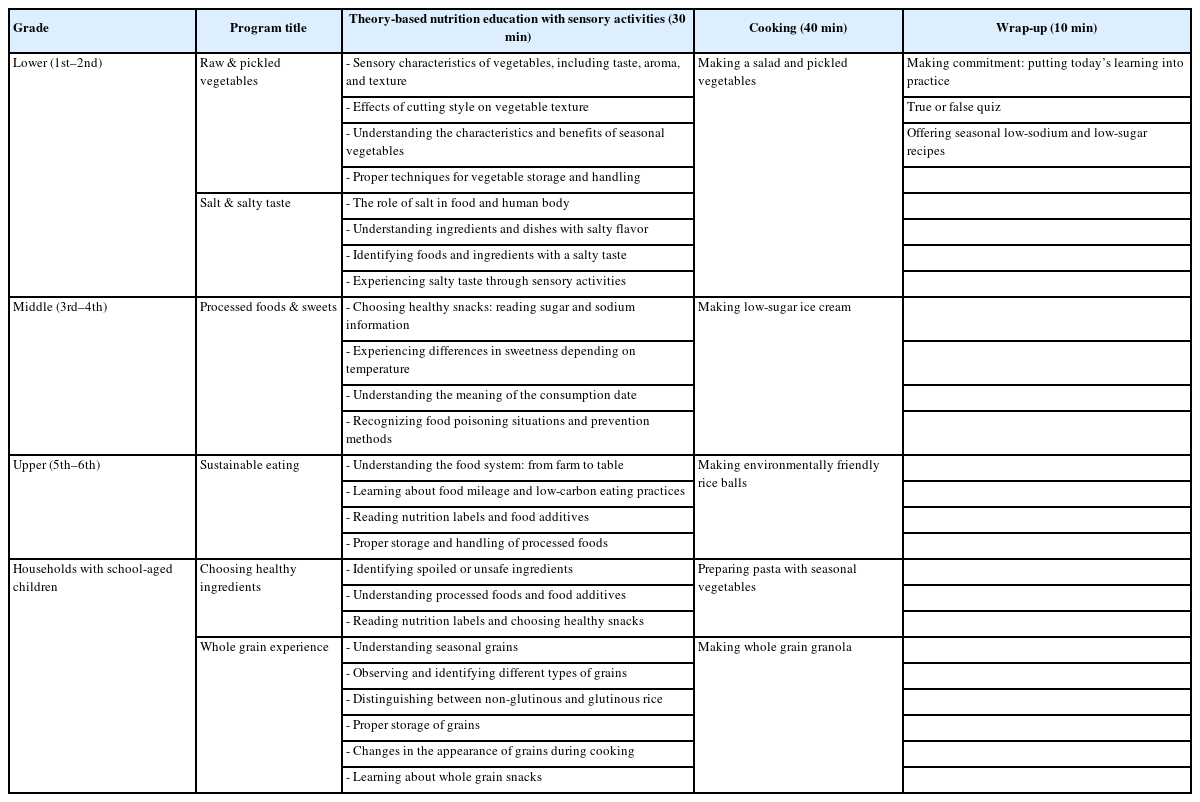Search
- Page Path
- HOME > Search
Research Note
- [English]
- Pilot evaluation of a cooking-based nutrition education program to promote vegetable intake among children in Seoul, South Korea: a single-group pre–post study
- Sil-Ah Kim, Su-Jin Lee, Min-Ah Kim, Ji-Eun Oh, Sohyun Park, Hyun-Joo Ryou, Ji-Yun Hwang
- Korean J Community Nutr 2025;30(4):249-260. Published online August 29, 2025
- DOI: https://doi.org/10.5720/kjcn.2025.00220

-
 Abstract
Abstract
 PDF
PDF PubReader
PubReader ePub
ePub - Objectives
Food neophobia in children is often associated with limited exposure and familiarity to some foods. Cooking-based nutrition education (CBNE), which promotes acceptance through direct experience, may support the development of healthy eating habits. This study aimed to develop and implement a standardized CBNE program for school-aged children in Seoul, South Korea, and to evaluate its effectiveness by assessing changes in raw vegetable intake. Raw vegetable intake is an early indicator of the effectiveness of nutrition education on diverse topics in promoting healthy eating habits.
Methods
A single-group pre–post study was conducted with 37 children aged 6–11 years who participated in a 2-day CBNE program in October 2023. The participants completed pre- and post-education questionnaires and raw vegetable intake assessments. Four low-preference vegetables (bell pepper, carrot, cucumber, and tomato) were selected and served raw (25 g each) before and after the program. Intake changes were analyzed using paired t-tests, and Pearson’s correlation and hierarchical regression analyses were performed to identify predictors.
Results
Total raw vegetable intake significantly increased post-education (P = 0.008), particularly for carrots (P = 0.023). By subgroup, raw vegetable intake significantly increased in girls, upper-grade students, and those who consumed four or more vegetable side dishes per meal. Hierarchical regression analysis revealed that while vegetable preference was initially significant, vegetable-related experiences (β = 0.395, P = 0.026) and diversity of vegetable side dishes per meal (β = 0.403, P = 0.032) were stronger predictors in the final model (adj R2 = 0.333).
Conclusion
The CBNE program may enhance vegetable intake in children. Although preference remained the strongest individual factor, vegetable experience and the diversity of vegetable side dishes per meal had a greater combined effect. These findings underscore the importance of repeated and diverse exposure, not only by supporting previous studies that link such exposure to increased intake but also by suggesting that environmental support may be essential for sustaining healthy eating habits.
- 468 View
- 23 Download

Research Article
- [Korean]
- Comparison of the Sodium and Sugar Reduction Practices at Samsam Foodservices and General Foodservices in Daegu
- Sung-young Kwon, Kilye Kim, Yeon-Kyung Lee
- Korean J Community Nutr 2021;26(4):270-279. Published online August 31, 2021
- DOI: https://doi.org/10.5720/kjcn.2021.26.4.270
-
 Abstract
Abstract
 PDF
PDF - Objectives
The purpose of this study was to evaluate the effect of the sodium and sugar reduction practices of the Samsam foodservice project of Daegu, in comparison with that of general foodservices in Daegu. Methods: A survey was conducted on 80 Samsam foodservice workers and 80 general foodservice workers from Sep. to Oct. 2020. We compared each worker's taste preferences, stage of behavior change and dietary behavior regarding sodium and sugar, and each foodservice's practices regarding sodium and sugar reduction. Results: There was no significant difference between the salty taste and sweet taste preferences between the workers at the Samsam foodservices and those at the general foodservices. The percentage of foodservice workers in action or maintenance stage of behavior change for eating less salty was higher in the Samsam foodservices than in the general foodservices (P < 0.05). In addition, regarding the degree of saltiness and sweetness of meals, the workers at the general foodservices perceived their meals to be saltier (P < 0.001) and sweeter (P < 0.01) than the workers at Samsam foodservices. The workers at Samsam foodservices had fewer salty dietary behaviors compared to the workers at general foodservices (P < 0.01). The sodium reduction practice was significantly higher in the Samsam foodservices than the general foodservices (P < 0.001), especially in “efforts to make the food as bland as possible overall” (P < 0.001), and “serving less soup and stew” (P < 0.001). The sugar reduction practice too was significantly higher in the Samsam foodservices than the general foodservices (P < 0.001). Conclusions: The Samsam foodservices were shown to be better in the practice of sodium and sugar reduction compared to general foodservices. Therefore, it is necessary to provide continuous and practical support and incentives at the national level to expand the sodium and sugar reduction practices in foodservices. -
Citations
Citations to this article as recorded by- Comparison of participant and non-participant perceptions on healthy restaurant for sodium reduction: a qualitative study
Jeehee Pyo, Mina Lee, Yunjeong Jang, Minsu Ock
Nutrition Research and Practice.2023; 17(3): 503. CrossRef
- Comparison of participant and non-participant perceptions on healthy restaurant for sodium reduction: a qualitative study
- 583 View
- 4 Download
- 1 Crossref


 KSCN
KSCN

 First
First Prev
Prev



